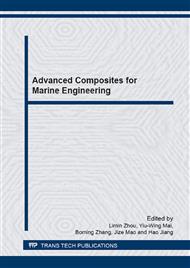p.3
p.10
p.19
p.28
p.35
p.43
p.54
p.63
p.72
Scarfing Repair Parameters Optimization for Composite Laminates
Abstract:
Scarf repair parameters were optimized in this paper, to find the best repair parameter, and get better strength restoration effect. Composite laminates material was IM6/3501-6. Considering symmetry of structure, 1/4 repaired structure was taken as research object, to be built up finite element model and optimized for repair parameter. Element SOLID46 in software ANSYS was used to simulate main board and patch, element SOLID45 was used to simulate adhesive layer, to build up composite scarf repair finite element model. Because of small scarf repair angle and small ratio of adhesive layer thickness to composite laminate thickness, repair structure geometry was complex, to get exact calculation result, mesh was refined at place where stress is concentrated. There were 4488 element in the built up finite element model, with nodes number as 6263. Tsai-Wu rule and maximum shear stress was taken as failure criteria for composites laminate and adhesive layer respectively. With consideration on scarf ratio and adhesive layer thickness on repaired specimen strength, three dimension finite element models for scarf repair on composite laminates was constructed. Compared with experiment, it was found that finite element model agreed with experiment, thus validity of scarf repair model was proved. By Changing the value of each factor, finite element calculation of the repaired structure failure load showed that: the optimal value of scarf ratio is 1:20; influence of adhesive layer thickness of failure load of scarf repair structure is not obvious, generally 0.1mm meets the requirements; failure load increases when adhesive layer elastic modulus increases, but the rate of increase slows down gradually. Then the earliest failure site was analyzed according to finite element stress calculation result, failure process of adhesive layer was simulated, adhesive layer failure process was predicted, from 0 degrees to 45 degrees, and the adhesive layer top part first destroys, then spreads to 45 degrees to 90 degrees, and spreads to the adhesive layer lower end.
Info:
Periodical:
Pages:
35-42
Citation:
Online since:
March 2015
Authors:
Price:
Сopyright:
© 2015 Trans Tech Publications Ltd. All Rights Reserved
Share:
Citation:


